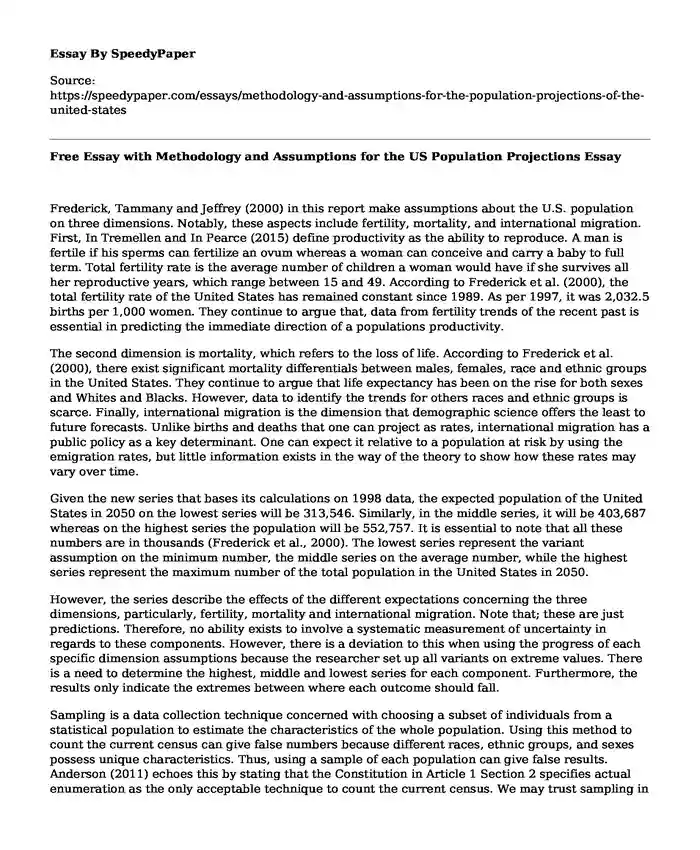
| Type of paper: | Essay |
| Categories: | United States Sociology Population |
| Pages: | 3 |
| Wordcount: | 653 words |
Frederick, Tammany and Jeffrey (2000) in this report make assumptions about the U.S. population on three dimensions. Notably, these aspects include fertility, mortality, and international migration. First, In Tremellen and In Pearce (2015) define productivity as the ability to reproduce. A man is fertile if his sperms can fertilize an ovum whereas a woman can conceive and carry a baby to full term. Total fertility rate is the average number of children a woman would have if she survives all her reproductive years, which range between 15 and 49. According to Frederick et al. (2000), the total fertility rate of the United States has remained constant since 1989. As per 1997, it was 2,032.5 births per 1,000 women. They continue to argue that, data from fertility trends of the recent past is essential in predicting the immediate direction of a populations productivity.
The second dimension is mortality, which refers to the loss of life. According to Frederick et al. (2000), there exist significant mortality differentials between males, females, race and ethnic groups in the United States. They continue to argue that life expectancy has been on the rise for both sexes and Whites and Blacks. However, data to identify the trends for others races and ethnic groups is scarce. Finally, international migration is the dimension that demographic science offers the least to future forecasts. Unlike births and deaths that one can project as rates, international migration has a public policy as a key determinant. One can expect it relative to a population at risk by using the emigration rates, but little information exists in the way of the theory to show how these rates may vary over time.
Given the new series that bases its calculations on 1998 data, the expected population of the United States in 2050 on the lowest series will be 313,546. Similarly, in the middle series, it will be 403,687 whereas on the highest series the population will be 552,757. It is essential to note that all these numbers are in thousands (Frederick et al., 2000). The lowest series represent the variant assumption on the minimum number, the middle series on the average number, while the highest series represent the maximum number of the total population in the United States in 2050.
However, the series describe the effects of the different expectations concerning the three dimensions, particularly, fertility, mortality and international migration. Note that; these are just predictions. Therefore, no ability exists to involve a systematic measurement of uncertainty in regards to these components. However, there is a deviation to this when using the progress of each specific dimension assumptions because the researcher set up all variants on extreme values. There is a need to determine the highest, middle and lowest series for each component. Furthermore, the results only indicate the extremes between where each outcome should fall.
Sampling is a data collection technique concerned with choosing a subset of individuals from a statistical population to estimate the characteristics of the whole population. Using this method to count the current census can give false numbers because different races, ethnic groups, and sexes possess unique characteristics. Thus, using a sample of each population can give false results. Anderson (2011) echoes this by stating that the Constitution in Article 1 Section 2 specifies actual enumeration as the only acceptable technique to count the current census. We may trust sampling in an audit population. However, this math would not hold up for the census itself because instead of estimates, the government seeks to get exact figures of the total population.
References
Anderson, M. (2011). Baker v. Carr, the census, and the political and statistical geography of the United States: the origin and impact of Public Law 94-171. Case W. Res. L. Rev., 62, 1153.
Frederick, W. H., Tammany, J. M., & Jeffrey, E. K. (2000, January). Methodology and Assumptions for the Population Projections of the United States: 1999 to 2100. Retrieved from http://www.census.gov/population/www/documentation/twps0038/twps0038.html#B2
In Tremellen, K., & In Pearce, K. (2015). Nutrition, fertility, and human reproductive function.
Cite this page
Free Essay with Methodology and Assumptions for the US Population Projections. (2019, Oct 24). Retrieved from https://speedypaper.com/essays/methodology-and-assumptions-for-the-population-projections-of-the-united-states
Request Removal
If you are the original author of this essay and no longer wish to have it published on the SpeedyPaper website, please click below to request its removal:
- Strategic Management Essay Example
- Development of Human Resource Management. Essay Sample.
- Essay Example on Mad Men and the Paradox of the Past
- Essay Sample: The Business Environment and Culture of Mexico
- What Is Katz's Main Argument Regarding Porn and What It Does? Free Essay
- Gerrymandering and Racial Inequality: Unveiling Political Manipulation in the United States - Paper Example
- Exploring Philosophical Positions: Unveiling Political Philosophy, Meta-Ethics, and Critical Theory - Essay Sample
Popular categories




